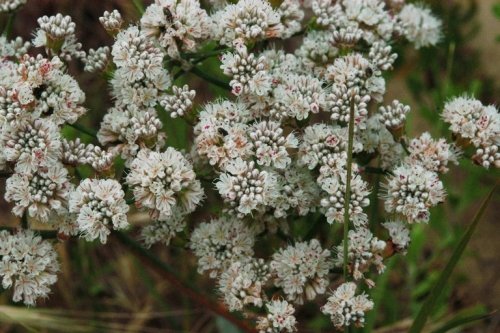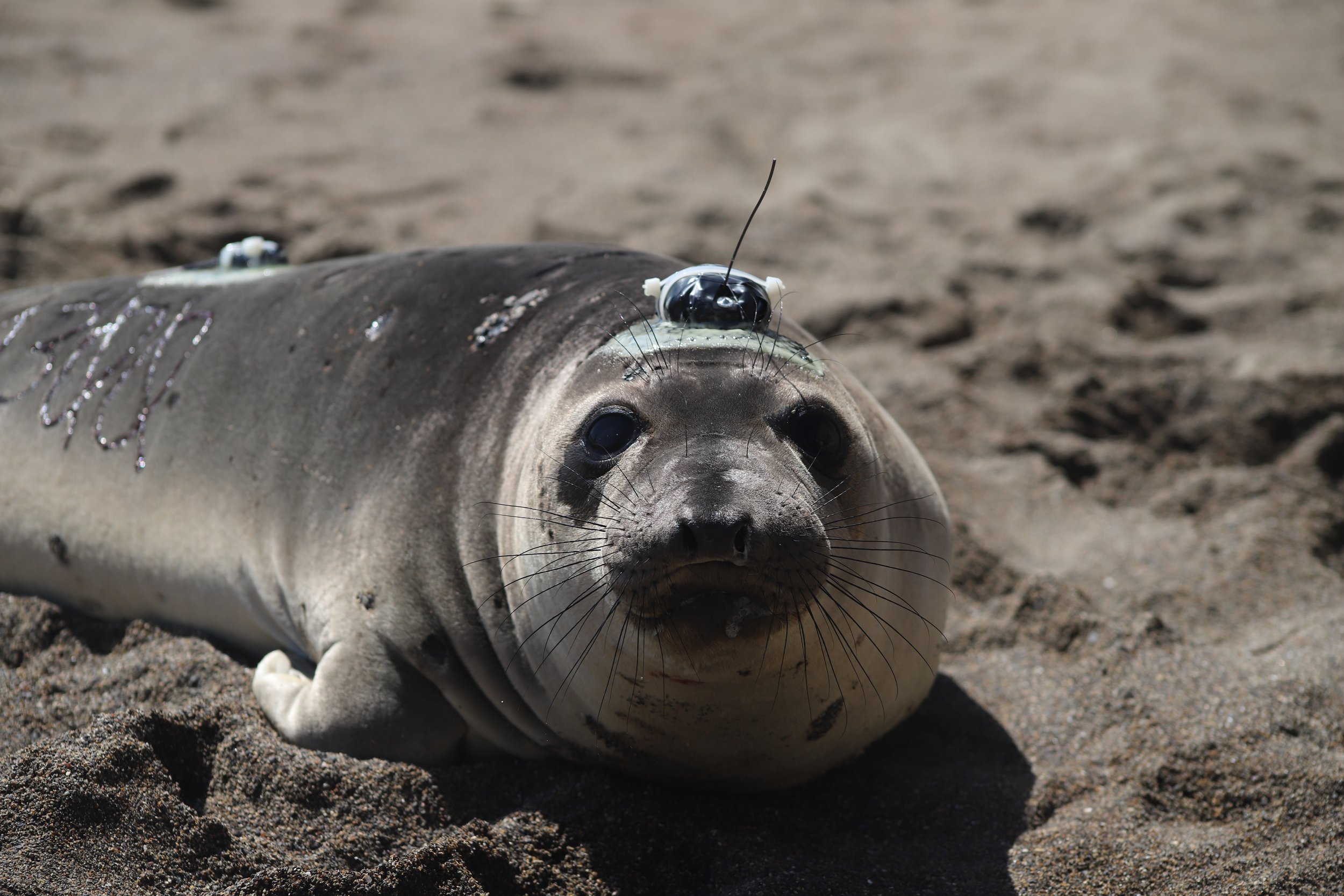Movement of weaned northern elephant seal pups
during their first at-sea foraging migration
Weaned elephant seal pup with a satellite tag on his head. Activities performed and image taken under NMFS permit 22187-04.
The northern elephant seal is an amazing marine mammal that embarks on huge foraging migrations each year. Adult males venture all the way up the coast to Alaska, and adult females go hundreds of mile out into open ocean. Despite the extensive knowledge the scientific community has on adult migrations in this species, very little is known about where the pups go when they first leave the beach.
Northern elephant seal pups are typically born in December and January, and they nurse for 4 weeks before they are weaned. After weaning, they remain on the beach for 6-8 weeks, completing their development and occasionally swimming nearshore, or in coastal ponds and rivers. Once they get hungry enough, they leave the beach and venture into the ocean to find food. Our project aims to determine the migration pathways of weaned northern elephant seal pups during their very first foraging migration.
This year, we tagged weaned pups at Vandenberg Space Force Base (Lompoc, CA) and on San Nicolas Island, CA, to compare the migration patterns of pups born at a newly established breeding site (Vandenberg) and a long-established site (San Nicolas).
Meet our seals!
Photo credit: Heather Harris
Chukar
Date tagged: 04/08/2023
Sex: Female
Mass: 97.8 kg (215.6 lb)
Chukar was our first seal tagged at San Nicolas Island. We named her after the chukar (Alectoris chukar), which is a land bird found all over the island. The chukar was introduced to the island in 1968 by a group of men stationed there, who wanted to hunt them as a past-time. Since then, the chukar population has grown and it is a very prevalent species on the island.
Photo credit: Gary A. Monroe
Buckwheat
Date tagged: 04/08/2023
Sex: Female
Mass: 95.4 kg (210.3 lb)
Buckwheat was a very goofy seal, who was seen playing with a rock prior to us tagging her. She would pick up the rock with her mouth and push it around with her flipper! She was also very curious and came up to us while we were setting up our gear. We named her after San Nicolas Island buckwheat (Eriogonum grande var. timorum), which ranges across the island. The plant is a perennial herb that is found on dry cliffs and is estimated to support multiple species of moths and butterflies.
Photo credit: Heather Harris
Coreopsis
Date tagged: 04/08/2023
Sex: Male
Mass: 118 kg (260 lb)
Coreopsis was the largest seal we tagged this season. Due to his size, we thought it was appropriate to name him after the giant coreopsis (Leptosyne gigantea). The giant coreopsis is a unique-looking perennial plant that looks like it was drawn by Dr. Seuss. It is often found on the bluffs overlooking the ocean and has beautiful yellow flowers in the spring.
Photo credit: Robert Lovich
Night Lizard
Date tagged: 04/09/2023
Sex: Male
Mass: 103.8 kg (228.8 lb)
Night Lizard was named after the island night lizard (Xantusia riversiana), which is an endemic species found only on Santa Barbara, San Nicolas, and San Clemente Islands. Despite its name the island night lizard is not nocturnal and is most active in the middle of the day. One unique life history trait is that night lizards give birth to live young instead of laying eggs, which is uncommon among reptiles.
Photo credit: Heather Harris
Fox
Date tagged: 04/09/2023
Sex: Male
Mass: 108.4 kg (239 lb)
Fox was named after the San Nicolas Island fox (Urocyon littoralis dickeyi), which is a descendent of the mainland gray fox. Although the island fox is one of the smallest canid species in the world (about the size of a domestic cat), it is the largest native terrestrial mammal on the island. The island fox also has no natural predators, so they are active during the day and are very bold!
Photo credit: Carl Page
Goby
Date tagged: 04/13/2023
Sex: Female
Mass: 97.8 kg (215.6 lb)
Goby was our first seal tagged at Vandenberg this year, and she had a lot of beach tar all over her. This tar is completely natural and doesn’t hurt the seal, but it made it difficult for us to attach a tag! Goby was named after the tidewater goby (Eucyclogobius newberryi), which is a fish native to brackish water lagoons, estuaries, and marshes along the California coast. Because their habitat is subject to significant temperature and salinity changes, gobies are extremely resilient to environemental changes. Despite this, the goby began disappearing from many of its historical habitats and was listed as endangered under the Endangered Species Act in 1994.
Photo credit: Kenneth Dwain Harrelson
Monarch
Date tagged: 04/13/2023
Sex: Female
Mass: 97.8 kg (215.6 lb)
This beautiful little seal was named after the charismatic monarch butterfly (Danaus plexippus). This species of butterfly undergoes long migrations, flying as far north as southern Canada in the summer and as far south as San Diego, CA in the winter. What is really interesting about this migration - and very different from the migration of elephant seals - is that it is multigenerational. Each butterfly only lives for a few weeks to a few months, so each generation completes a part of the migration. A population of monarch butterflies utilizes the eucalyptus groves at Vandenberg during the winter.
Photo: earth.com
Fairy Shrimp
Date tagged: 04/13/2023
Sex: Male
Mass: 101.2 kg (223 lb)
Fairy shrimp was a very feisty seal, named after the vernal pool fairy shrimp (Branchinecta lynchi). The vernal pool fairy shrimp is a small, freshwater crustacean found in vernal pools in California and southern Oregon. They are opportunistic filter feeders that swim through the water upside down by beating their 11 pairs of legs in a wave-like movement. Due to habitat loss, fragmentation, and other impacts, they were listed as threatened in 1994.
Photo: National Wildlife Federation
Frog
Date tagged: 04/14/2023
Sex: Male
Mass: 112 kg (247 lb)
Frog was named after a native California species, the California red-legged frog (Rana draytonii). These frogs can be found in slow-moving or still bodies of water. They are known for their reddish underside and two ridges that run parallel along the back. During the breeding season, the males will communicate with females using a series of grunts, and then end the call with a growl. Frog the seal definitely did his fair share of grunting while we were working with him! California red-legged frogs are listed as threatened under the Endangered Species Act, and were designated as the California state amphibian in 2014.
Photo: U.S. Fish & Wildlife Service
Plover
Date tagged: 04/14/2023
Sex: Female
Mass: 81.8 kg (180.3 lb)
Plover was the smallest seal we tagged this year, so it is fitting that she is named after a very small, cute bird, the snowy plover (Charadrius nivosus). The snowy plover is a shorebird that ranges from southern Washington to southern Baja California, Mexico, and breeds along the California coast. This species is a small, light-colored ground nesting bird that will forage for crustaceans in the wet sand and will eat beach flies found in the washed-up kelp and seaweed. Because they nest directly on the sand, plovers are very sensitive to human activities, which has resulted in their decline. These birds are currently listed as threatened under the Endangered Species Act.
Curious about our satellite tagged seals from 2022? Click here to see their tracks and profiles!





















